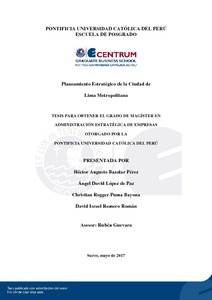| dc.contributor.advisor | Guevara Moncada, Rubén | |
| dc.contributor.author | Bazalar Pérez, Héctor Augusto | es_ES |
| dc.contributor.author | López de Paz, Ángel David | es_ES |
| dc.contributor.author | Puma Bayona, Christian Rogger | es_ES |
| dc.contributor.author | Romero Román, David Israel | es_ES |
| dc.date.accessioned | 2017-06-13T23:19:29Z | |
| dc.date.available | 2017-06-13T23:19:29Z | |
| dc.date.created | 2017 | |
| dc.date.issued | 2017-06-13 | |
| dc.identifier.uri | http://hdl.handle.net/20.500.12404/8784 | |
| dc.description.abstract | Siguiendo el modelo secuencial, que fue desarrollado por D’Alessio (2015), se elaboró el
presente plan estratégico para la ciudad de Lima Metropolitana, con miras al año 2026. El
objetivo es que Lima Metropolitana se convierta en una ciudad inteligente, donde sus
habitantes gocen de una excelente calidad de vida, la cual se manifestará en acceso a los
servicios básicos, a la educación y en general a oportunidades de desarrollo. Esto permitirá a
los limeños alcanzar una esperanza de vida al nacer superior a los 80 años de edad. La
principal oportunidad que tiene la ciudad de Lima Metropolitana es que cuenta con un
mercado nacional de más de 31 millones de personas, concentradas en esta ciudad, que
además es la capital del gobierno nacional. Esta gran población es una fuente de demanda
para distintos bienes y servicios, con una población que ha aumentado su capacidad de
consumo en los últimos 10 años, como consecuencia del crecimiento económico. Por otro
lado, al desarrollar la auditoría interna, se encontró que la principal fortaleza de la ciudad
radica en que se tienen proyectos de construcción de infraestructura vial que beneficiarán a
diversos distritos, lo cual dará solución a debilidades profundas como la carencia de vías o de
un sistema de transporte integrado que atienda a la mayoría de la población. Además, hay
otras fortalezas como: (a) ser la sede de las principales asociaciones empresariales del país,
como la Cámara de Comercio de Lima, (b) diversificación económica, con crecimiento del
VAB sostenido; (c) actividades económicas de valor agregado, entre otras. Asimismo, las
debilidades de la ciudad de Lima Metropolitana se producen porque no todas las
municipalidades distritales tienen el mismo nivel de eficiencia administrativa y calidad en sus
servicios, mientras que los tiempos de traslado son muy altos, porque hay deficiencias en la
infraestructura vial | es_ES |
| dc.description.abstract | Using the Sequential Model, which was developed by D'Alessio (2015), the present strategic
plan for the city of Lima Metropolitana has been elaborated with a view to the year 2026. The
objective is that Lima becomes a smart city, where its inhabitants Enjoy an excellent quality
of life, which will be manifested in access to basic services, education and general
development opportunities. This will allow Limeños to have a life expectancy at birth above
80 years of age. The main opportunity that has the city of Metropolitan Lima is that it has a
national market of more than 31 million people, concentrated in this city, which is also the
capital of the national government. This large population is a source of demand for different
goods and services, with a population that has seen its consumption capacity increased in the
last 10 years as a result of economic growth. Through an internal audit, it was found that the
main strength of the city lies in the construction of road infrastructure projects that will
benefit various districts, which will address deep weaknesses such as lack of roads or an
integrated transportation system that The majority of the population. In addition, there are
other strengths, such as: (a) headquarters of the main business associations of the country,
such as the Lima Chamber of Commerce; (B) economic diversification, with sustained GVA
growth; And (c) economic activities of value added, among others. The weaknesses of the
city of Metropolitan Lima occur because not all district municipalities have the same level of
administrative efficiency and quality in their services, while the transportation times are very
high, because there are deficiencies in the road infrastructure | es_ES |
| dc.language.iso | spa | es_ES |
| dc.publisher | Pontificia Universidad Católica del Perú | es_ES |
| dc.rights | info:eu-repo/semantics/openAccess | es_ES |
| dc.rights.uri | http://creativecommons.org/licenses/by-nc-nd/2.5/pe/ | * |
| dc.subject | Planificación regional -- Perú -- Lima | es_ES |
| dc.subject | Desarrollo regional -- Perú -- Lima | es_ES |
| dc.subject | Planificación estratégica | es_ES |
| dc.title | Planeamiento estratégico de la Ciudad de Lima Metropolitana | es_ES |
| dc.type | info:eu-repo/semantics/masterThesis | es_ES |
| thesis.degree.name | Maestro en Administración Estratégica de Empresas | es_ES |
| thesis.degree.level | Maestría | es_ES |
| thesis.degree.grantor | Pontificia Universidad Católica del Perú. CENTRUM | es_ES |
| thesis.degree.discipline | Administración Estratégica de Empresas | es_ES |
| renati.advisor.orcid | https://orcid.org/0000-0002-4795-2557 | es_ES |
| renati.discipline | 413307 | es_ES |
| renati.level | https://purl.org/pe-repo/renati/level#maestro | es_ES |
| renati.type | https://purl.org/pe-repo/renati/type#tesis | es_ES |
| dc.publisher.country | PE | es_ES |
| dc.subject.ocde | https://purl.org/pe-repo/ocde/ford#5.02.04 | es_ES |






